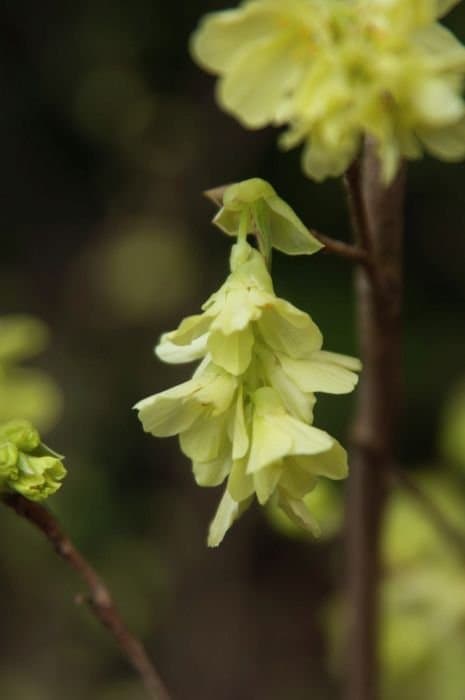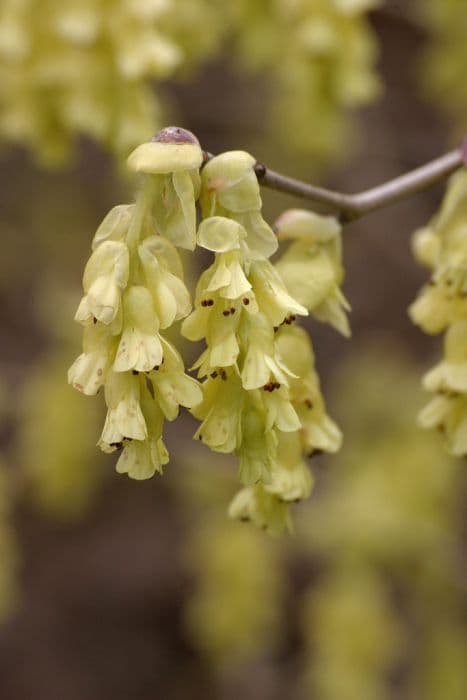Witch Hazel Hamamelis × intermedia

ABOUT
The plant commonly referred to as witch hazel is a deciduous shrub known for its unique and striking flowers. These blossoms are one of the plant's most distinctive features, typically appearing in the late winter to early spring when not many other plants are in bloom. The flowers consist of narrow, ribbon-like petals that radiate from the center like a small burst of fireworks. They can come in a range of colors, from yellow to orange and red, often emitting a delicate, spicy fragrance that adds to their allure. Witch hazel has broad, oval to obovate leaves that are arranged alternately on the branches. These leaves usually have wavy or slightly toothed margins and can turn to a beautiful array of gold, orange, and red tones in the fall, creating a showy display before they drop. The branches are somewhat irregular and can form a dense, multi-stemmed plant, providing a rich texture within a garden setting. The bark of witch hazel is smooth and gray-brown, which can become somewhat more rugged and textured as the plant matures. This plant also produces fruit, which are small capsules that split open in the fall to eject seeds with enough force to travel some distance. Overall, witch hazel is known for its unique blooms, pleasant fragrance, attractive autumn foliage, and sculptural branches, making it a favored choice in many gardens for year-round interest.
About this plant
 Names
NamesFamily
Hamamelidaceae
Synonyms
Hybrid Witch Hazel, Winterbloom
Common names
Hamamelis × intermedia.
 Toxicity
ToxicityTo humans
Witch hazel, which is the common name for Hamamelis × intermedia, is not considered highly toxic to humans. There are no well-documented cases of poisoning from the ingestion of witch hazel. However, as with many plants, it is still recommended to avoid ingesting parts of this plant as they may cause mild stomach upset or an allergic reaction in some individuals.
To pets
Witch hazel is also not known to be highly toxic to pets. However, it is generally advisable to prevent pets from ingesting plants. Consuming parts of the witch hazel plant might result in mild gastrointestinal upset, such as vomiting or diarrhea, if ingested in large amounts. Pets with specific sensitivities might have allergic reactions, although such cases are not commonly reported.
 Characteristics
CharacteristicsLife cycle
Perennials
Foliage type
Deciduous
Color of leaves
Green
Flower color
Varies
Height
12 feet (3.66 meters)
Spread
12 feet (3.66 meters)
Plant type
Shrub
Hardiness zones
5
Native area
Cultivar
Benefits
 General Benefits
General Benefits- Landscape Aesthetics: Hamamelis × intermedia, commonly known as witch hazel, is valued for its unique, fragrant, spider-like flowers which bloom in late winter to early spring, often when little else does, providing visual interest during a drab time of year.
- Winter Interest: Because witch hazel flowers during the winter, it offers seasonal interest when many other plants are dormant, adding color and life to the garden during the colder months.
- Attracts Pollinators: Even in its off-season bloom period, witch hazel can attract pollinators that are active in the winter, providing a valuable food source for them.
- Low Maintenance: Witch hazel is generally easy to care for once established and does not require much maintenance, making it a convenient choice for gardeners of all skill levels.
- Versatile Planting: This plant is adaptable to a variety of soil conditions and can be used in different landscape designs, from woodland gardens to formal borders.
- Tolerance to Various Conditions: Witch hazel is resilient and can tolerate conditions like pollution and occasional drought, which is beneficial for urban gardens and less-than-ideal growing situations.
- Fall Foliage: The leaves of witch hazel can turn attractive shades of yellow to red in the autumn, adding another season of interest.
- Supports Biodiversity: By providing flowers in the winter and habitat in other seasons, witch hazel supports biodiversity in the garden.
 Medical Properties
Medical PropertiesThis plant is not used for medical purposes.
 Air-purifying Qualities
Air-purifying QualitiesThis plant is not specifically known for air purifying qualities.
 Other Uses
Other Uses- Witch Hazel branches are often used for dowsing or water divining, a traditional way of finding underground water sources by feeling the pull of the branches.
- Garden designers value Witch Hazel for its winter interest, as it flowers during a time when little else is blooming in the garden.
- The unique and fragrant flowers of Witch Hazel make it a popular choice for winter bouquets and floral arrangements.
- Witch Hazel extract is commonly used in skincare and cosmetic products, thanks to its gentle astringent and soothing properties.
- The plant can be used as a natural insect repellent, thanks to certain compounds found in its leaves and bark that insects find unpalatable.
- Witch Hazel is used in some cultures for spiritual protection; its twigs and branches are included in talismans or charms.
- Photographers and painters often use Witch Hazel as a subject in their art due to its striking appearance and the challenge of capturing its winter blooming.
- Eco-friendly dyes for fabrics can be obtained from the bark and leaves of Witch Hazel, providing a range of warm, earthy tones.
- People interested in making natural crafts might use Witch Hazel’s seed pods and spent flowers for creating botanical prints or for inclusion in paper making.
- Bird enthusiasts may cultivate Witch Hazel in their yards to attract certain species, such as the Cedar Waxwing, that feed on the plant's seeds.
Interesting Facts
 Feng Shui
Feng ShuiThe Witch Hazel is not used in Feng Shui practice.
 Zodiac Sign Compitability
Zodiac Sign CompitabilityThe Witch Hazel is not used in astrology practice.
 Plant Symbolism
Plant Symbolism- Healing: The common name for Hamamelis × intermedia is Witch Hazel, which has often been associated with healing due to its medicinal properties. Witch Hazel extract is commonly used for its soothing and astringent qualities.
- Protection: Historically, Witch Hazel was believed to ward off negative influences and provide protection. This may be tied to the folklore of witches using twigs of Witch Hazel for divining and as a tool for finding water or protecting against evil spirits.
- Nature's Resilience: Witch Hazel is known for its ability to bloom in the winter, symbolizing nature's resilience and the idea that life can thrive even under the harshest conditions.
 Water
WaterWitch Hazel should be watered deeply once a week, providing a total of about 1 to 1.5 gallons of water each time to ensure the soil stays consistently moist but not oversaturated. During dry spells or exceptionally hot weather, increase watering frequency to twice a week. In the winter or during periods of rainfall, you can reduce watering but never allow the soil to completely dry out. The aim is to mimic a naturally moist environment, as that is where Witch Hazel thrives best.
 Light
LightWitch Hazel prefers full sun to partial shade. It thrives in a spot that receives at least 4-6 hours of direct sunlight each day but can also perform well when it gets filtered sunlight in a slightly shaded area. Avoid deep shade locations as this can reduce the plant's vigor and flowering potential.
 Temperature
TemperatureWitch Hazel can tolerate a wide range of temperatures, surviving minimum winters temperatures ofdown to about -10°F, but it does best in areas where the average temperature ranges between 30°F to 75°F. Extreme heat above 85°F can stress the plant; it is more tolerant of cold than it is of extreme heat.
 Pruning
PruningPrune Witch Hazel immediately after flowering, typically in late winter or early spring, to remove any dead or crossing branches and to maintain its shape. This timing allows for the full display of its fragrant winter blooms and ensures that new growth is not affected, which is where next season's flowers will appear. Pruning can be done annually, but extensive pruning should only be done every few years to keep the plant healthy and well-formed.
 Cleaning
CleaningAs needed
 Soil
SoilWitch Hazel prefers well-draining, loamy soil enriched with organic matter. A mix containing perlite and compost is ideal, ensuring good aeration and moisture retention. Aim for a soil pH of 5.5 to 6.5 to facilitate optimal nutrient uptake.
 Repotting
RepottingWitch Hazel is typically a garden plant, not a houseplant, and therefore would not require repotting. In a garden setting, transplantation is only necessary if the plant outgrows its location or if conditions necessitate a move.
 Humidity & Misting
Humidity & MistingWitch Hazel thrives in average outdoor humidity levels. It is tolerant of a range of humidity conditions and does not require specific humidity adjustments when planted in its natural outdoor environment.
 Suitable locations
Suitable locationsIndoor
Place Witch Hazel near bright window; ensure ample space.
Outdoor
Plant in sun to part shade, shelter from wind.
Hardiness zone
5-8 USDA
 Life cycle
Life cycleThe life cycle of Witch Hazel (Hamamelis × intermedia) begins with germination, where the plant emerges from seeds typically after stratification, a process that softens the seed coat. Once germinated, it enters the seedling stage, developing a root system and leaves to start photosynthesis. The plant then transitions to the vegetative growth phase, where it develops a woody structure and foliage, continuing to mature over several years. During each late winter to early spring, Witch Hazel enters its reproductive phase, producing fragrant yellow to red flowers, which are notable for their ribbon-like petals. The flowers are followed by the development of fruit capsules that burst open in autumn to disperse seeds, completing the cycle. The plant also experiences a period of dormancy annually, typically in the winter, where growth slows down significantly.
 Propogation
PropogationPropogation time
Late winter to early spring
For the Witch Hazel (Hamamelis × intermedia), the most popular method of propagation is through softwood cuttings. This is typically done in late spring to early summer, when the new growth is still tender but has started to mature. The process involves cutting a section of the stem that is about 4 to 6 inches long, with several leaves attached. The bottom of the cutting should be dipped into a rooting hormone to encourage root development. It is then inserted into a well-draining potting mix and kept moist and warm until roots have developed, which usually takes several weeks. The use of a plastic covering can help maintain necessary humidity levels. Once the cutting has rooted, it can be transplanted into a larger pot or directly into the garden.









